3 KEY TAKEAWAYS from Canada's performances at 2023 World Cup

Canada dreamed of reaching the highest summit in women's soccer, but after three games in the group stage of the 2023 FIFA Women's World Cup, the reigning Olympic gold medalists fell short and bowed out of the tournament after suffering a 4-0 defeat to Australia on Monday.
It was far from the result Canada would have been looking for heading into this make-or-break game. Jessie Fleming said it was a "bad night to have a bad night," while manager Bev Priestman took some time to stay positive, offering that "Australia is a top, top side" and that "there's nothing stopping them from pushing through this because they should be probably in the top four of a World Cup."
Unfortunately, advancing from Group B came down to needing a result against not only a top side, but a host nation as well. Priestman and the Canadian women's team won't be looking for an excuse as to why they were eliminated, but the situation encapsulates what the World Cup is about: Much like the men’s side, both teams were put up against tough groups and missed out on the knockouts by a few moments.
So, while they bow out of the tournaments with less than they'd like, there is a lot to be taken away from AU / NZ.
Next generation given vital experience
 Regardless of how they fared, Canada gave invaluable experience to some younger talent in more prominant roles, finally signalling the end of the old guard and ushering in the next crop of Canadian talent.
Regardless of how they fared, Canada gave invaluable experience to some younger talent in more prominant roles, finally signalling the end of the old guard and ushering in the next crop of Canadian talent.
U-23s Jordyn Huitema, Jayde Riviere and Julia Grosso featured in all three of Bev Priestman’s starting XIs at the tournament, selected over veteran options like Sophie Schmidt, Allysha Chapman and Christine Sinclair. Kailen Sheridan got her first major tournament under her belt, while Jessie Fleming took on the mantle of leader and key playmaker. While Cloe Lacasse and Evelyne Viens couldn't translate their remarkable club scoring form on this stage, they also had parts to play coming off the bench. No Desiree Scott meant the midfield took on a new look, too.
Whether Priestman’s decisions were influenced by her wanting to give experience to the younger players or simply from a belief that this was the best possible Canadian side to send out, there’s no denying that having these minutes under their collective belts will benefit them as they grow into their role as starters for Canada in the years to come.
The goal-scoring problem remains unsolved

Sometimes, the best lesson you can learn is a harsh truth, and in Canada's case, it's time to be honest: Goal-scoring is a problem.
Sure, replacing the production of one of the greatest to ever play was never going to be an easy task, and the reliance on Christine Sinclair over the last few years has, perhaps, hampered Canada's ability to evolve. While Sinclair was limited in her ability to impact matches at the World Cup, she remained a clear option throughout the tournament, and one has to wonder if that was to Canada's ultimate detriment.
Without a set no. 9 in the team sheet, Priestman went with a separate option in each of the team's group stage matches – and none of the lot were able to make a noticeable impression.
Only one goal was scored by a Canadian player at the World Cup, and that was courtesy of Adriana Leon. Ironically, she came into the World Cup in the worst of club circumstances and form, but continued to prove that she can move past her club struggles on the international stage.
The focus now has to be on getting her teammates to translate to country at the same rate. Rather than replacing Sinclair, Canada need to shape the attack around some combination of two or three (or four?) and stick with it. This team continues to demonstrate a lack of substance and ideation in the attacking third. Huitema has scored once in 16 matches for Canada. The 5-foot-10 centre-forward was used out wide at times. Is that really her best role?
Yes, Canada has a defensive identity, but this team can’t ignore their offensive shape and strategy, either (or concede four goals, as such).
Midfield two or three, Quinn is here to stay
 Possibly Canada’s most consistent and noteworthy performances at this tournament came from Quinn in midfield.
Possibly Canada’s most consistent and noteworthy performances at this tournament came from Quinn in midfield.
The 27-year-old was very impressive in all three of their starts, only making way for a substitution once in the tournament for debuting Olivia Smith to get a cameo late in the last match vs. Australia.
Quinn offered stability and composure on the ball, leading all Canadian midfielders / attackers in passes and touches, and only losing the ball once over the three games. They helped Canada dominate possession, holding at least 60 percent in each group stage matches; they'd also impact play with frequent defensive actions and were vital in maintaining control of the ball in midfield.
Whatever the midfield combination turns out to be for Canada in the future, Quinn proved themselves more than worthy to be in that conversation with their performance at this tournament.